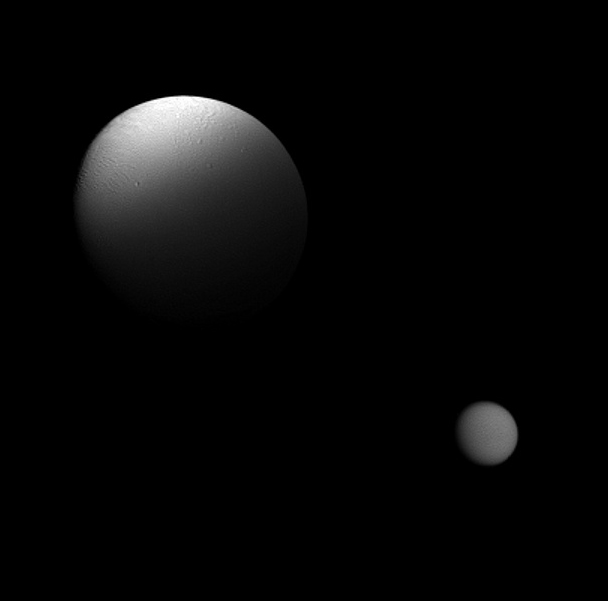Create a free profile to get unlimited access to exclusive videos, sweepstakes, and more!
Saturn eclipses an icy moon

The mighty planet Saturn is circled by a fleet of moons, each as different from the other as individual people. And as weird and alien as it seems, this Saturnian system of planet and moons have some similarities to our own Earth and Moon. For example, as they orbit Saturn, the moons can be eclipsed by it when they pass behind the planet and into its shadow.
The Cassini spacecraft caught exactly this event as the icy moon Enceladus slipped into Saturn's shadow last October... and there's more here than might initially meet the eye:
That's amazing [click to penumbrenate]. But it may not be obvious what you're seeing at first! Enceladus is the moon to the upper left. It's about 500 kilometers (330 miles) across, and its surface is almost entirely water ice. At the time this shot was taken, it was about 26,000 km (16,000 miles) from Cassini.
If the moon were just sitting out there, half of it would be lit by the Sun, and half would be in darkness. Cassini was off to the side a bit when this was taken, so we see the hemisphere that is almost entirely lit by the Sun. The day/night line - called the terminator - runs from the upper left to lower right of the moon on its left side as seen here.
But because Enceladus was partially into Saturn's shadow, the sunlit side of the moon that would normally be painfully bright is dusky and dark. The shadow is deepest toward the bottom of the moon. The geometry of this scene depends on so many angles! The terminator line, the position of Cassini relative to the moon and Sun, the position of Saturn, and even the curve of the planet itself as its shadow envelops the moon.
And we're not done. Photobombing the scene at the lower right is the monster moon Titan, which is 10 times bigger in diameter than Enceladus! But it was over a million kilometers away from Cassini when this picture was taken, so it actually looks smaller than its very much smaller sibling. It appears dark, even compared to the shadowed Enceladus, because Titan only reflects about 1/5th of the light that hits it, while shinier Enceladus reflects almost all the light that impinges on its icy surface.
Funny, too: the edge of Titan looks fuzzy, because it has a thick atmosphere. Enceladus has no atmosphere, but still looks a bit fuzzy as well due to Saturn's shadow: the planet does have an atmosphere, so the shadow itself isn't sharp.
The complexities of understanding even a seemingly simple picture are ridiculous when that picture comes from Saturn. But that's so often true: things do appear easy at first glance, but far more complicated when you peer more deeply. The Universe, as are human affairs, is rarely so black-and-white.
Image credit: NASA/JPL-Caltech/Space Science Institute
Related Posts:
- The more distant moon
- A shadow falls on the ice geysers of Enceladus
- Midnight on a ringed world
- Titan's shadow















